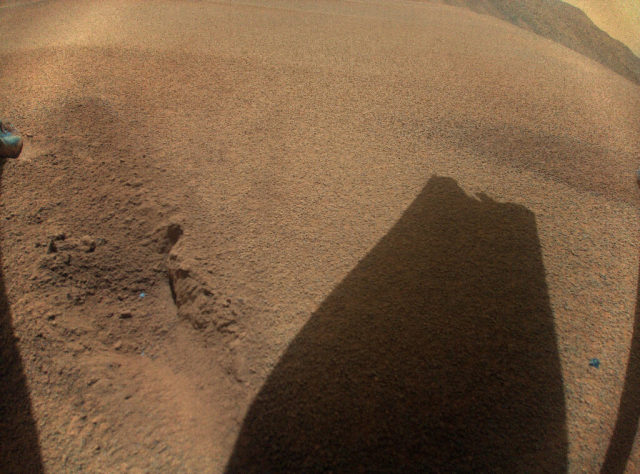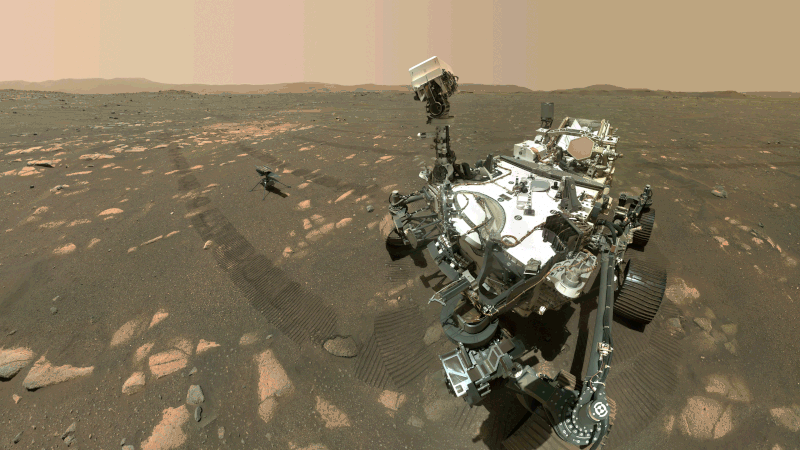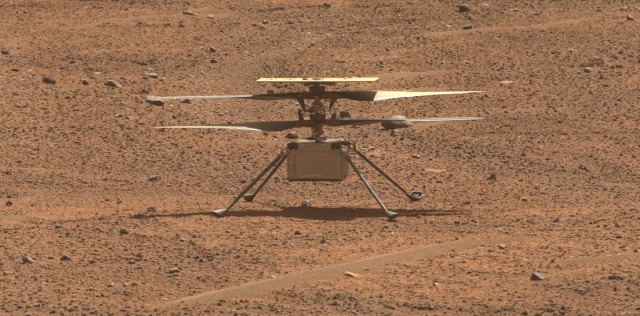He had to break away from the surface of the Red Planet at least once, and eventually did it 72 times. Designed for only a month of operation, the Martian helicopter has served for almost three years. A technology demonstrator designed to be a simple proof of concept, it has done much more. The Ingenuity kid is retiring, and we'll take a look at how a drone made of components that were not intended for space at all revolutionized space exploration.
You get used to good things quickly. If at first almost the whole world followed the news about the progress of the Ingenuity mission, then in the second year the blog of the Martian helicopter was regularly checked only by the most devoted fans of cosmonautics. The thought that he could fail at any moment was forgotten. He flies and flies, sometimes there are some problems, but it doesn't happen to anyone, right? There has never been a mission without problems. But you can't fool physics, sooner or later something has to break.
Disturbing news came on January 19, when the line "communication between the rover and the helicopter was interrupted before the last landing" appeared in the flight report number 72. A couple of days later, Ingenuity was able to "get through" and receive telemetry, as well as images from its cameras. The finish line. Further operation is impossible — one of the blades has become smaller by a quarter. The fact that the helicopter stands vertically on its legs is already a miracle.
 |
| The shadow of a broken blade on the Martian soil. |
| Source: NASA, JPL-Caltech |
What exactly happened on the 72nd flight is not yet fully clear. The helicopter was just supposed to confirm its operability and look around. The previous flight on January 6 ended with an emergency landing due to the activation of the protective program, so the mission team did not know the exact location of Ingenuity. On his 72nd flight, he climbed 12 meters, hung for four and a half seconds and began to descend at a speed of one meter per second. But at the last meter, the connection was interrupted, and when contact was made with the helicopter again, its blade was already broken.
According to the main version, the lack of data for the visual orientation system is to blame. During the flight, Ingenuity "understands" where it is by analyzing images of the Martian surface below it. If the details shift, it means that he is flying. If they stay in place, it is suspended in the air. But when the surface is monotonous, without a single pebble, the system can fail. This is the main hypothesis so far, which was reported by Howard Fjær Grip, the "honorary pilot" of the Martian helicopter at a briefing on January 25. It is confirmed by the fact that upon a detailed study of the images from the navigation camera, damage was found on another blade.
The mission team does not fully understand what exactly happened first: the disconnection somehow affected the behavior of Ingenuity or the connection was cut off due to the fact that the helicopter lost its orientation in space. Another likely option is the banal wear of parts. Diagnostic images after the 71st flight showed deformation of the blades. Perhaps the carbon fiber lost its strength over time, bent or cracked, which led to unstable behavior during flight.
Exceeded all expectations
Before moving on to the legacy of Ingenuity, the revolutionary paradigm shift in space exploration that caused the success of the Martian helicopter, let's pay tribute to its records. The original plan called for at least one flight and a maximum of five flights over 30 sols (Martian days). No one expected more, the main task of Ingenuity is to confirm the very possibility of controlled mechanized flight in the Martian atmosphere.
But he took off. Yes, not the first time, there were problems with the software. And then again. And more. The complete success of the Ingenuity mission was announced after the third flight. And a funny situation arose: the helicopter is fully operational, functioning better than expected, but it's time to abandon it. The fact is that the main mission of the Perseverance rover began, he could no longer stand still and watch his "younger comrade", simultaneously relaying signals to Earth.
 |
| An epochal Perseverance selfie with Ingenuity. |
| Source: NASA, JPL-Caltech, MSSS |
Then the Ingenuity team at the Jet Propulsion Laboratory (NASA JPL) proposed something that could only be dreamed of during the development of the Martian helicopter. What if he helps the rover, works as a scout? The procedures for the interaction of the two robots were slightly revised, and off we went. For the next two and a half years, Ingenuity served as additional "eyes" for its fellow Perseverance. He surveyed the area ahead along the planned route of the rover and took pictures of geological formations that it could not reach.
Instead of five flights, he made 72. Instead of a couple of minutes, he spent almost 129 (two hours, eight minutes and 55 seconds) in the Martian air. The total flight range reached 17,242 meters. The height is 24 meters, with a planned 12. And all this was done by a device in which most of the components were never intended to work in outer space or another planet.
The legacy of Ingenuity
It's worth starting with the fact that the Martian helicopter should not have happened. For a significant part of the entire time of the Mars 2020 project (the Perseverance rover mission), the idea of adding an alien helicopter technology demonstrator to the rover met with strong opposition. The leadership of the National Aeronautics and Space Administration of the United States (NASA), many eminent engineers and scientists — the largest personalities in American cosmonautics were against it.
It was only through enthusiasm, professionalism and the ability to convince that the Ingenuity team was able to provide its offspring with a place in the sun. To do this, it was literally necessary to prove that the helicopter would not interfere with the work of the rover in any way and would not create additional risks for it. Ingenuity was included in the main mission almost on a bird's—eye basis - hence the hard window of 30 sols for testing, low priority in communication sessions and the status of a technology demonstrator.
That's why the success of the helicopter is so significant. In the history of cosmonautics, if you dig deep enough, there are plenty of such wild ideas at first glance, like "let's add such a device to the main apparatus (module, accompanying small apparatus) just to try and check." And all of them are rigidly "hacked" even at the stage of discussing the concept. Of the successful ventures of this kind, only the balloon probes that formed the company of the Soviet AMC Vega, which explored the atmosphere of Venus, are immediately recalled. Characteristically, they are also aircraft, only not controlled and not mechanized.
Let's formulate the main theses, confirmed in practice by almost three years of Ingenuity's work.
- You can fly in the atmosphere of Mars.
- An apparatus assembled from components that have not been certified for aerospace use can successfully operate on another planet.
- Having a low organizational and scientific priority, a cheap technological demonstrator can be sent as a companion to the main mission without risk to it, and if successful, it will also multiply its results.
In theory, these points are not in doubt, especially since they have already been partially or completely verified. At least individually. The Ingenuity furore is that the Martian helicopter "collected bingo", which can now be used as an argument when planning future missions. The effect is already noticeable: two helicopters will be used to collect soil samples to the point of departure from Mars ( Mars Sample Return ). And on board the Psyche spacecraft, which went to the asteroid of the same name last December, there is a Deep Space Optical Communications (DSOC) instrument — the same technological demonstrator as Ingenuity. Only for data transmission using a laser beam.
Projects like Dragonfly, a multi-rotor flying robot for exploring Titan, Saturn's moon, are a separate story. This mission has been under development since the early 2000s and has managed to change its appearance at least twice. The success of Ingenuity, if it did not directly affect these changes, then it certainly added confidence to the engineers who are developing an ambitious device.
© JPL, NASA, YouTube
Instead of a conclusion
The Martian helicopter is far from the first project of JPL in particular and human cosmonautics in general, which radically exceeded all planned service life and tasks. We hope that it will not be the last one. Ingenuity will remain forever in the hearts of all space, science and technology lovers. Rest in peace, brave little conqueror of the extraterrestrial sky.


